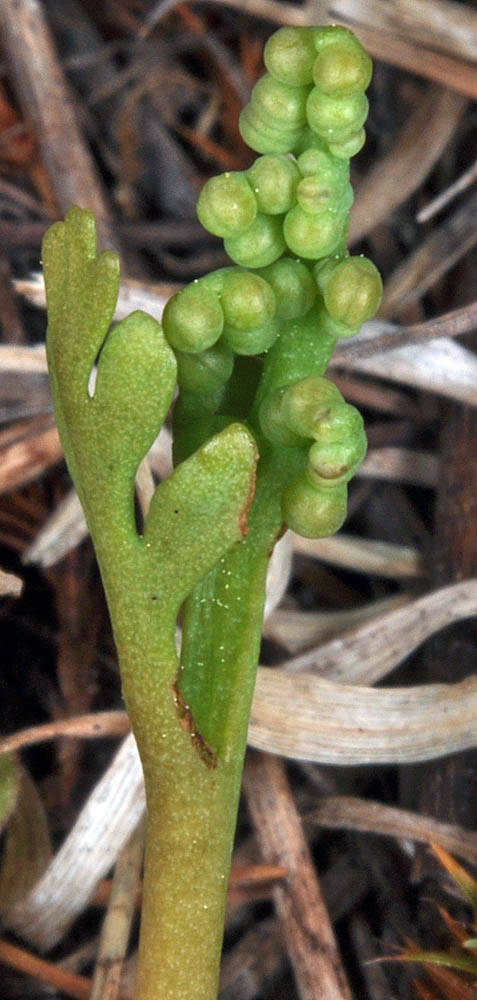Botrychium hesperium
Botrychium montanum
western moonwort
mountain moonwort, western goblin
37(29–50) μm.
54(47–57) μm.
well developed; greater than 3 cm, with a reddish brown stripe below the trophophore.
well developed; greater than 2 cm except in very small plants, green.
short-stalked (stalk usually shorter than distance between first and second pairs of pinnae);
blade pinnate-pinnatifid, subdeltate; to 5 cm long; dull gray-green and usually appearing glaucous;
pinnae ascending, usually overlapping; ovate to lanceolate, broadly attached to the rachis; broadest at or below the middle, asymmetrically lobed with basiscopic lobes enlarged;
pinnae lobes with rounded apices; the margins slightly rolled; lowest pinnae often exaggerated; up to twice as long as the adjacent pinnae;
sporangia rarely present on pinnae margins.
with stalk 0.3–2 cm long, usually comprising 25–50% or more the total trophophore length;
blade 1-pinnate, oblong to linear; to 4 × 1 cm; dull green, glaucous, often appearing fleshy;
pinnae to 3(5) pairs, often irregularly spaced with adjacent pinnae often confluent, sometimes completely fused to form a spoon-shaped blade, spreading to ascending; wedge-shaped with nearly parallel sides and a truncate or slightly rounded, often lacerate outer margin.
erect with stalk up to 2 times as long as the trophophore at spore release; in larger plants becoming ternately branched with lateral branches nearly as long as main axis.
stiffly erect;
stalk (0.5)1–3 times as long as the trophophore at spore release;
branches much reduced, often appearing absent.
=180 (allotetraploid, derived from B. lanceolatum and an unknown diploid).
=90.
Botrychium hesperium
Botrychium montanum
At upper montane to subalpine elevations in open, mesic meadows with low, herbaceous cover. Also in historically disturbed areas with gravelly soil, such as road shoulders, ski slopes, or mine tailings. 1400–1700 m. BW. ID, WA; western North America. Native.
Unpublished forms with deeply lobed pinnae (B. hesperium var. ���fenestratum’ and B. ‘venulosum’) do not warrant taxonomic recognition.
Moist duff around seeps or streams under mature Thuja plicata or, rarely, Picea engelmannii, at mid-montane elevations. Occasional in fen-like seeps or in moist to wet meadows with moss or lush herbaceous cover at subalpine elevations. 900– 2500 m. BW, Casc, ECas. CA, ID, WA; north to AK, northeast to MT. Native.
Botrychium montanum is our smallest moonwort.
Ben Legler
Ben Legler
- Local floras:
BC,
OR,
WA
- Local Web sites:
Flora NW,
PNW Herbaria
WildflowerSearch
iNaturalist (observations)
USDA Plants Database
- LBJ Wildflower Center
- SEINet
- Plants of the World Online
- Encyclopedia of Life
- Wikipedia
- Google Image Search
- Local floras:
BC,
CA,
OR,
WA
- Local Web sites:
CalFlora,
CalPhotos,
Flora NW,
PNW Herbaria
WildflowerSearch
iNaturalist (observations)
USDA Plants Database
- LBJ Wildflower Center
- SEINet
- Plants of the World Online
- Encyclopedia of Life
- Wikipedia
- Google Image Search





